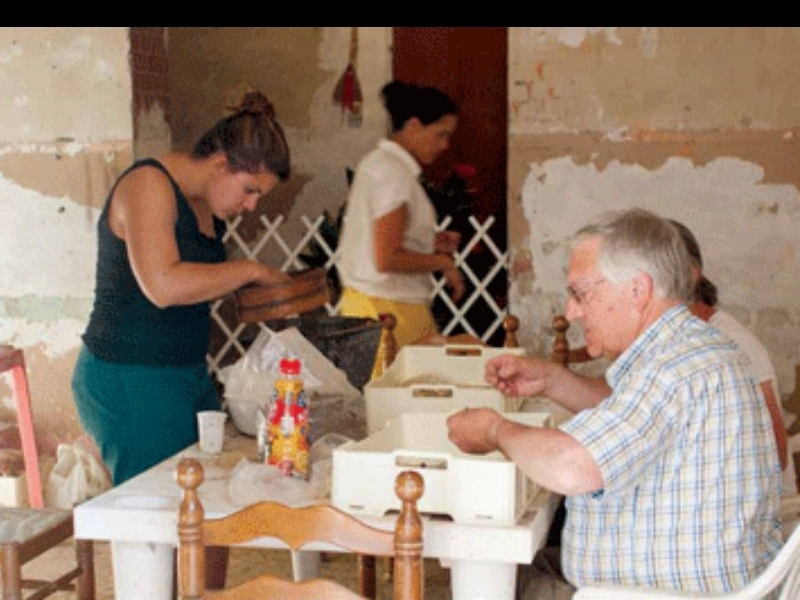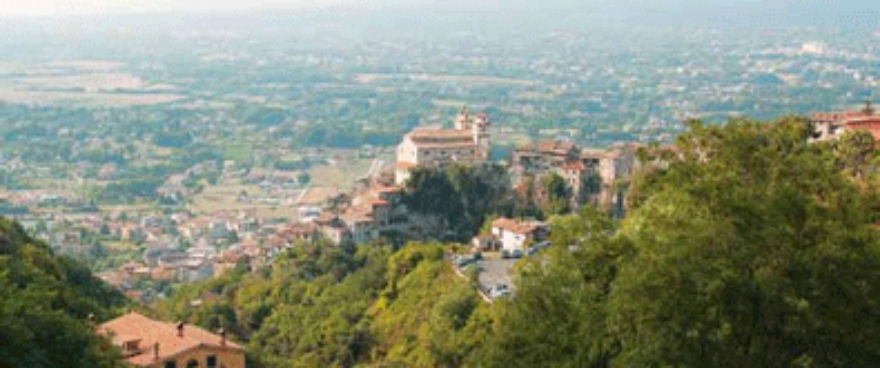Digging Italy

Story and photography by Maria Raha
How is your baby, Leah?"
"It’s coming along."
Leah Marangos, a graduate student at Rutgers University who previously studied at Temple University Rome, kneels at the edge of a small hole in the dirt. She is captivated by the remains she has found: a human baby, dated to approximately A.D. 400. She thinks the infant was likely buried in the shards of an amphora, or vessel, that surround the small bits of bone.
Marangos is one of six students taking a six–credit course called Archaeological Excavation in Artena, Italy, where they learn the process of an archaeological dig from “the pickaxe to the pencil”—all while immersed in the area’s rural culture. Since 2010, Temple students have headed to the top of a 2,000–foot Italian mountain to excavate an ancient Roman villa, in the blazing summer sun, with Temple University Rome instructor Jan Gadeyne.
The site overlooks the mountain town of Artena. According to Gadeyne, it is the largest pedestrian village in the world, but is largely unknown—even to most Italians. Given Artena’s truly rural culture—picture a slightly updated Sicily than was depicted in Godfather II—its differences from bustling, teeming Rome (located only 25 miles northwest) are striking. A maze of medieval buildings comprises the center of the town. Donkeys, laden with groceries and other unwieldy deliveries for the town’s residents, still traverse its narrow, winding and steep cobblestone streets. Across the road from Hotel Chiòcchiò, the staff of which warmly welcomes, houses and feeds Gadeyne’s students each summer, a farmer walks his horse around a track. Outside the hotel, a rooster crows and a parrot echoes its call. In other words, Artena is a far cry from North Philadelphia.
“It was really nice to see Italy’s rustica side after being in Rome for so long,” says Gina Roi, a senior graphic-design major who also has studied at Temple Rome. “We learn the local culture and attend town parties and events. One night, we jumped over fire because it’s cleansing—it’s a tradition here. It was really cool.”
ROMAN HOLIDAY?
The setting is idyllic, but the course is rigorous and the days are long. Students rise at 6 a.m. and meet in the humble lobby of the hotel. Onesto Coculo, Hotel Chiòcchiò’s owner, serves the team espresso or cappuccino and cookies before they head to the site, about one mile away and atop Artena.
Once they arrive at the site, the team follows what is left of the ancient road that leads to the villa and gets to work immediately. The sun is usually unforgiving; dust and bees whip around them as they dig. Throughout the day, Gadeyne and his research partner, Cécile Brouillard of the French Institute for Preventive Archaeology, guide the students’ techniques, document their own research and pitch in by digging vigorously. “How many PhDs do you know who sweat like this?” Gadeyne asks as he points to his sweat–soaked Temple Rome T–shirt.
Each day, the students quietly and patiently chip away at centuries of dirt and rock with pickaxes and hand trowels, voicing their hopes of uncovering a sarcophagus. In reality, discoveries at the site happen incrementally. When Temple seniors Brett Williams and Hannah Lents announce that they have found some bones, Gadeyne confirms the find, announces it to the group, and then says with a little sigh, “But, they could just be chicken bones.”
After a daily, midafternoon lunch at Broulliard’s summer home, just down the road from the dig, the students usually spend the afternoon washing, cataloging and varnishing the shards they have collected. The glittering pieces are left on the hotel terrace to dry overnight. (When Marangos finds what she quickly begins referring to as “my baby,” she foregoes washing potshards and spends the next two afternoons sifting those remains instead.)
Throughout the summer, Gadeyne also holds classes in museums and at historical sites, such as the Temple of Primigenia Virilis in Palestrina, a town on a mountain that faces Artena. Uncovered after a bombing during World War II, some of the imposing temple’s features predate the architectural wonder of Rome’s Pantheon by 250 years.
Each night at 8 p.m., the group shares a traditional, four– to five–course Italian dinner cooked by the kitchen staff of Hotel Chiòcchiò before shuffling to bed, exhausted and stuffed. On weekends, they are free to explore Artena, Rome and other cities across Europe.
REALITY BITES
Gadeyne notes that Archaeological Excavation also can help participants decide on—or against—a career path. The harsh reality of the day–to–day work without instantly learning the significance of what they are unearthing can help them steer clear of the field. “This course smashes the myth of archaeology,” Gadeyne says. “This is not the History Channel—this is hard labor.”
Though it is not the edited, sometimes grand stuff of documentary television, the site’s history is compelling on its own. Perched above Artena’s cluster of terracotta roofs in various states of repair, the ancient site sits on a cliff–like artificial terrace 50 feet higher than its surrounding hills. The Roman villa—the focus of the project—was inhabited from the first century B.C. until at least the fifth century A.D.
Thus far, Gadeyne, Brouillard, and their predecessors and apprentices have uncovered the foundations of numerous structures, including one with a mosaic floor, since preserved with a glass roof and a covering of pebbles and dirt; a wine or olive press room; a bath complex; an atrium; a cistern; and an aqueduct.
Ankle–high stone foundations line the site, all right angles and partial squares. The atrium is located in the middle of the terrace, now sheltered to provide the research team respite from the sun. The private bath complex, located diagonally from the atrium, is covered with a tarp that provides a cool place for the group to stash water. It sits a few feet below ground level, and is divided into two rooms separated by a brick wall. Gadeyne explains that one room would have been used for fire, and the heat would have flowed into the adjoining room through a small archway in the brick. On the other side of the atrium lies what is left of the wine or olive press, identified by the presence of an adjacent, in–ground basin.
Gadeyne notes that the site’s history mirrors the geopolitical history of Italy and the Mediterranean. The excavation has revealed evidence of early structures and an initial settlement in approximately the fourth century B.C., which was subsequently destroyed violently. “We’ve seen destruction through traces of fire in the buildings that have been excavated,” Gadeyne says.
The next phase of habitation began with the construction of the villa that flourished between the first century B.C. and the second century A.D. Further waves of occupation and abandonment occurred through the seventh century.
“We are dealing with a site that has existed for more than 1,000 years,” Gadeyne explains. “It begins in a time when Rome was not yet the capital of an empire, but was gradually expanding its influence—that’s the time of the town. Then you have the villa, when Rome was capital of the Empire and a big city that needed to be fed. This villa is one of the hundreds of farmhouses that produced for the capital. Then you have the phase when the countryside goes through a crisis.”
The later ups and downs of life on the terrace reflect the decline of the Roman Empire and then Rome’s existence under Germanic and Byzantine rule from 476 onward.
“I’m very interested in the material culture of early Christians, like A.D. 33 to like, 400,” says Hannah Lents, an anthropology major and president of the Newman Center, Temple’s Catholic community. “The time period we’re digging in is just after the time period I’m interested in, so it’s good for me to get the idea of what Rome is doing. I can see how it influenced this town.” Lents states that she has wanted to become an archaeologist since she was 6 years old. And though a month in the dust might drive some students away, the experience has only fueled her fire. “Hannah, do you still want to be an archaeologist?” Gadeyne asks. Lents answers by smiling, nodding and jumping up and down simultaneously.
DIG INTO THE PAST
For others, Archaeological Excavation is the first dig in which they have participated. For example, Brett Williams, a senior sculpture major in the Tyler School of Art, came to Artena to explore how memory and environment intersect.
Williams applied for the class after studying for a semester in Rome and hearing about Gadeyne. But Gadeyne was not the only reason he returned to Italy to study. His love of Italy aside, the course is informing his art.
“I’m interested in environment and space, and how I change in different places,” Williams explains. “I thought being here—abroad, but in a setting other than Rome—would be interesting, especially excavating a villa and how that environment changes through the history of time. People settled there, and digging into their past and history is really interesting.”
Though the students are briefed via Skype before their arrival, they plunge right into the work after a day of settling in to life in the countryside.
“You don’t really get a lot of direction about how to dig,” says Kelley Stone, TYL ’12, an alumna who is on her third trip to the dig. Now an employee at the Barnes Foundation in Philadelphia, she took a two–week vacation to return as a volunteer this past summer.
“You figure it out yourself and Jan corrects you as you go. You learn by doing.”
RURAL CULTURE
Gadeyne also is committed to including the residents of Artena in the project. “We don’t want to be a foreign presence here,” he says. “This isn’t our site—it’s theirs."
Local community members sporadically show up at the dig to help. One local man provides the group with wild plums; another’s sheep cheese is served with dinner at the hotel. And when swaths of land or towering piles of dirt need to be moved at the site, the latter supplies the team with tractors.
“We are in a very rural community, and that means that we must establish a good relationship with the local community,” Gadeyne explains. “We try to make them aware of their heritage. We participate in cultural events here; we occasionally give lectures; we give tours. They are starting to understand the value of the area we are excavating.”
Lents, who is bubbly and energetic in the evenings, is so focused on her task at the dig, she rarely looks up, speaks or smiles—unless she is asked about Artena. “Artena’s awesome,” she states. “The thing about it is, you see the villa, which is what you might think of Rome—the aristocracy and all that jazz. But where we’re digging is not all nice, clean columns—we’re uncovering piles of rocks and saying, ’What is this? What were they thinking?’ And then eventually, we say,’Oh! This is pavement!’ It’s exciting.”
